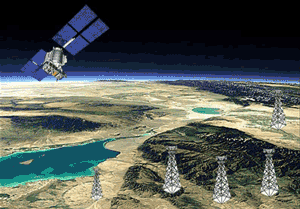 |
||||||||||||||||||||||||||||||||||||

Sergey A. ShapovalovFaculty of Computer Information Technologies and AutomaticsDepartment of Automation and TelecommunicationSpeciality: Telecommunication Systems and NetworksTopic of master's work:Analysis of impact of increasing level of "radiosmog" of the Earth on the quality of operation of receive path of satellite communication channels and search for improvement methodsScientific adviser: Alexander Grigoryevich Vorontsov, Professor, Doctor of engineering | ||||||||||||||||||||||||||||||||||||
Review on the topic of master's thesisIntroductionFrequency band 3.4–4.2 GHz (so called C-band) is now used by satellite services especially satellite television. Because of its resilience in the presence of heavy rain it is also used for earth broadband wireless access systems (BWA). One of most developed BWA technologies is WiМAX (802.16а standard). Frequency bands used by this technology overlap this satellite signal and cause significant problems to satellite video signal. Soon WiMAX stations will cover the Earth and create so called radiosmog disrupting receiving systems not only on the Earth but also in space. This issue was discussed among several field forums: Global VSAT Forum (GVF), WiMAX Forum, GVF and the Satellite Users Interference Reduction Group (SUIRG). Results of trials and investigations presented in November, 2007 showed that WiMAX stations cause serious problems for satellite receiving systems [1].
Fig.1 – Animation "Interference in satellite channels, which was made by the stations WiMAX" ( frames: 5, cycles: 7 )
The main objective of our research is estimation of level of interference to satellite receiving centers located on geostationary orbit due to BWA systems. We assume that interference may be caused by fringe radiation of antennas of earth transmitters and by radiation of main-lobes of earth transmitters located in fringe zone of the area covered by satellite antenna. To estimate influence of fringe radiation of BWA antenna we apply standard energy calculation of signal channel to earth satellite station and a network of many WiMAX stations located on coaxial circles around it ([2],[3]). See initial data in the Table 1.
Table 1.Initial data for calculation of satellite signal path.
Energy calculation allows us to estimate energy parameters of signal and satellite receiving system. Here we use the following formulas. Equivalent isotropic radiated power of transmitter:
Attenuation of energy in free space:
Equivalent noise temperature of reciever:
Noise power of satellite receiving antenna:
There are also additional interference Lдоп due to atmosphere factors (hydrometeors and absorption of radio waves). Total value of interference is L=L0+Lдоп. Using [4] we get Lдоп=6,81 dB. For estimation of fringe radiation we will take WiMAX stations with output power 29 dBmW. For such stations level of sidelobe radiation is less than -30 dB [5] and directional diagram is parallel to Earth surface. Power of sidelobe signal that gets into satellite receiving antenna is -1dBW. Coverage zone of satellite receiving antenna is an ellipse (or circle as a particular case). Radius of this zone is about 664 km, and area is 1384414 sq. km. Radius of WiMAX coverage zone is 12 km, area is 453 sq.km. 3057 WiMAX stations cover the same area as our satellite antenna. Real number of WiMAX stations will be about 20–25% of this theoretical estimation, so interference may be caused by less than 1000 transmitters. Assume that directional diagram of satellite antenna is uniformly distributed from center to sides. Let us introduce a coefficient of overlapping for directional diagrams of transmitting antennas K that shows what part of Peirp of other stations will get into satellite channel. Let it be 0,707 at the edges of directional diagram and 1 at the center. So total signal at the input of satellite receiving system due to side-lobe radiation of 1000 WiMAX transmitters is:
Total power of stations is less than acceptable power of noise at the input of satellite receiver. The difference is -139,9+127,4=12,8 dB that is less than required -14 dB. This means that WiMAX stations create interference that may impair the quality of satellite receiver. Sum of WiMAX signal and power of noise at the input of receiver is -126,3 dBW. Then signal/noise level is -113,4-(-127,2)=13,8 dB. Let Тw be noise temperature due to WiMAX stations. Initial total equivalent noise temperature of receiving system is:
Then total noise temperature for WiMAX signal added to noises at the input of receiver is:
Conclusions and future researchTo reach initial level of signal/noise at the input of demodulator and initial energy parameters of satellite channel we have to reduce the level of noise temperature by 30 К. Most appropriate methods are reduction of waive guide length and coverage of inner walls of waive guide by gold or silver to smoothen it. Theoretically these methods would allow creation a waiveguide with high coefficient of efficiency. But in practice this is by far not so easy. Another method is reduction of noise temperature of low-noise amplified. Reduction of noise temperature of amplifier may be 21 K due to 1000 WiMAX stations and there will be 9 K compensating interference due to other WBA stations. So reduction of noise temperature of amplifier significantly reduces influence of earth wireless networks. This way we will reach initial level signal/noise and reduce bit error rate. We will continue with investigation and development of amplifier with low noise coefficient to improve quality of satellite signals and diminish influence of interference due to earth systems. References
|
© DonNTU, Shapovalov Sergey






